2016 CITROEN C-ELYSÉE ECU
[x] Cancel search: ECUPage 47 of 260

45
C-elysee_en_Chap03_confort_ed01-2016
Rear seats
F Move the corresponding front seat for ward i
f necessary.
F
C
heck that the corresponding seat belt is
p
ositioned correctly against the backrest
a
nd buckle it. F
S traighten the seat backrest 2 and s
ecure it.
F
U
nbuckle and reposition the seat belt on
t
he side of the backrest.
When
repositioning the seat backrest,
t
ake care not to trap the seat belts.
Ensure
that the backrest has latched
p
roperly into place.
F
P ull the strap 1 to release the seat backrest 2.
F F old the seat backrest 2 on to the cushion.
Folding the backrest
Depending on version, your vehicle may be fitted with a fixed rear bench seat. For removing and refitting it, contact a CITROËN dealer or a qualified w
orkshop.
Bench
seat with fixed one-piece cushion and split backrest (left hand 2/3, right hand 1/3) which can be folded individually to adapt the load space in the boot.
Repositioning the seat backrest
3
Comfort
Page 88 of 260

86
C-elysee_en_Chap05_conduite_ed01-2016
F Turn thumb wheel 1 to the
"LIMIT" position:
the speed limiter
m
ode is selected but is not switched on
(
PAUS E).
You
do not have to switch the speed limiter
o
n in order to set the speed.
Programming Leaving limiter mode
F Turn thumb wheel 1 to the "0" position: t
he speed limiter mode is deselected. The
d
isplay returns to the distance recorder.
On
a steep descent or in the event of
s
harp acceleration, the speed limiter
w
ill not be able to prevent the vehicle
from
exceeding the programmed speed.
To
avoid any risk of jamming of the
ped
als:
-
e
nsure that the mat is secured
c
o r r e c t l y,
-
d
o not fit one mat on top of another.
In
the event of a speed limiter fault, the speed
i
s cleared and the dashes then flash.
Have
it checked by a CITROËN dealer or a
q
ualified
w
orkshop.
Operating fault
F Set the speed value by pressing button 2 or 3 (e.g.: 55 mph (
90 km/h)).
You
can then change the programmed speed using buttons 2 and 3:
-
b
y + or - 1 mph (km/h) = short press,
-
b
y + or - 5 mph (km/h) = long press,
-
i
n steps of + or - 5 mph (km/h) = maintained press.
Exceeding the programmed speed
Pressing the accelerator pedal to exceed the programmed speed will not have any effect unless you press the pedal firmly past the point of
resistance .
The
speed
limiter
is
deactivated
temporarily
and
the
programmed
speed,
w
hich is still displayed, flashes, accompanied by an audible signal.
Returning
to the programmed speed, by means of intentional or
u
nintentional deceleration of the vehicle, automatically cancels the
f
lashing of the programmed speed and the audible signal stops.
F
S
witch the speed limiter back on by pressing button 4
ag
ain.
F
S
witch the speed limiter on by pressing button 4
.
F
S
witch the speed limiter off by pressing button 4
: the display
c
onfirms that it has been switched off (PAUSE).
Driving
Page 90 of 260

88
C-elysee_en_Chap05_conduite_ed01-2016
F Turn thumb wheel 1 to the
"CRUISE" position:
the cruise control
m
ode is selected but is not switched on
(
PAUS E).
Programming
You can then change the programmed speed using buttons 2 and 3:
- b y + or - 1 mph (km/h) = short press,
-
b
y + or - 5 mph (km/h) = long press,
-
i
n steps of + or - 5 mph (km/h) = maintained press. When
the cruise control is switched on,
b
e careful if you maintain the pressure
o
n one of the programmed speed
c
hanging buttons: this may result in a
v
ery rapid change in the speed of your
v
ehicle.
Do not use the cruise control on
slippery
roads or in heavy traffic.
On
a steep descent, the cruise control
w
ill not be able to prevent the vehicle
from
exceeding the programmed speed.
To
avoid any risk of jamming of the
ped
als:
-
e
nsure that the mat is secured
c
o r r e c t l y,
-
n
ever fit one mat on top of another.
In
the event of a cruise control malfunction,
t
he speed is cleared resulting in flashing of the d
ashes. Have it checked by a CITROËN dealer o
r a qualified workshop.
Operating fault
Leaving cruise control mode
F Turn thumb wheel 1 to the "0" position: the cruise control mode is d
eselected. The display returns to the distance recorder.
Exceeding the programmed speed
Intentional or unintentional exceeding of the programmed speed results in flashing of this speed in the screen.
Return
to the programmed speed, by means of intentional or
u
nintentional deceleration of the vehicle, automatically cancels the
f
lashing of the speed.F
S
et the programmed speed by
a
ccelerating to the required speed,
t
hen press button 2 or 3 (e.g.: 70 mph
(
110 km/h)).
F
S
witch off the cruise control by pressing button 4
: the screen
c
onfirms that it has been switched off (PAUSE).
F
S
witch the cruise control back on by pressing button 4
ag
ain.
Driving
Page 102 of 260

100
C-elysee_en_Chap07_securite_ed01-2016
Direction indicators
F Left: lower the lighting stalk beyond the p
oint of resistance.
F
R
ight: raise the lighting stalk beyond the
p
oint of resistance.
Three flashes of the direction
indicators
F Press briefly upwards or downwards, w
ithout going beyond the point of
r
esistance; the direction indicators will
f
lash 3 times.
Hazard warning lam ps
Automatic operation of
hazard warning lamps
When braking in an emergency, depending on t
he deceleration, the hazard warning lamps
c
ome on automatically.
They
switch off automatically the first time you
a
ccelerate.
F
Y
ou can also switch them off by pressing
t
he button.
F
P
ress this button, all of the direction
in
dicators
f
lash.
They can operate with the ignition off.
Horn
F Press
the central part of the steering w
heel.
Audible
warning system to alert other road
u
sers to an imminent danger.
Visual
warning
with
of
all
the
direction
i
ndicators
flashing
to
alert
other
road
users
to
a
v
ehicle
breakdown,
towing
or
accident.
Safety
Page 103 of 260

101
C-elysee_en_Chap07_securite_ed01-2016
Under-inflation detection
The under-inflation detection system d
oes not replace the need for vigilance
o
n the part of the driver.
This
system does not avoid the need to
c
heck the tyre pressures (including the
s
pare wheel) every month as well as
b
efore a long journey.
Driving
with under-inflated tyres impairs
r
oad holding, extends braking distances
a
nd causes premature tyre wear,
p
articularly under arduous condition
(
high loading, high speed, long journey).The
inflation pressures defined for y
our vehicle can be found on the tyre
p
ressure label.
For
more information on the
i
dentification markings, refer to the
c
orresponding
s
ection.
Tyre
pressures should be checked
w
hen the tyres are "cold" (vehicle
s
topped for 1 hour or after a journey of
l
ess than 6 miles (10 km) at moderate
s
peeds).
Other wise
(when hot), add 0.3 bar to
t
he pressures shown on the label.
Driving
with under-inflated tyres
i
ncreases fuel consumption.
System
which
automatically
checks
the
pressures
of
the
tyres while driving.
The
system
monitors
the
pressures
in
the
four
t
yres,
once
the
vehicle
is
moving.
It
compares
the
information
given
by
the
four
w
heel
speed
sensors
with
reference values,
which must be reinitialised ever y time the
tyre pressures are adjusted or a wheel
changed .
The
system
triggers
an
alert
as
soon
as
it
d
etects
a
drop
in
the
inflation
pressure
of
one
o
r
more
tyres.
7
S
Page 104 of 260

102
C-elysee_en_Chap07_securite_ed01-2016
Before reinitialising the system, ensure that the pressures of the four tyres are
correct
for the use of the vehicle and in
l
ine with the recommendations on the
t
yre pressure label.
The
under-inflation alert can only be
r
elied on if the reinitialisation of the
s
ystem has done with the pressures in
t
he four tyres correctly adjusted.
The
under-inflation detection system
d
oes not give a warning if a pressure is
i
ncorrect at the time of reinitialisation.
The
loss
of
pressure
detected
does
not
a
lways
cause
visible
bulging
of
the
tyre.
D
o
not
satisfy
yourself
with
just
a
visual
c
heck. The
alert
is
maintained
until
the
system
i
s
r
einitialised.
Under-inflation alert
This is given by fixed illumination of t his warning lamp, accompanied by
a
n audible signal and the display of a
m
essage.
F
R
educe speed immediately, avoid
e
xcessive steering movements and sudden
b
raking
F
S
top the vehicle as soon as it is safe to
do so. F
I f you have a compressor (such as the one
i
n the temporary puncture repair kit), check
t
he pressures of the four tyres when cold.
I
f it is not possible to carry out this check
s
traight away, drive carefully at reduced
s
peed.
or
F
I
n the event of a puncture, use the
temporary
puncture repair kit or the spare
w
heel (depending on equipment),
Reinitialisation
It is necessary to reinitialise the system every time one or more tyre pressures are adjusted,
a
nd after changing one or more wheels.
Safety
Page 105 of 260

103
C-elysee_en_Chap07_securite_ed01-2016
Reinitialisation of the system must be done with the ignition on and the vehicle stationary:
- i n the vehicle configuration menu for vehicles fitted with a display screen,
-
u
sing the button in the glove box for vehicles without display screen.
Monochrome screen C
F Press the "7" or " 8" button to select the
" Driving assistance ",
category, then
c
onfirm by pressing the central button.
F
P
ress the " 7" or " 8", button to select " Ty r e
pressures" , then "Reinitialisation ", then
confirming
by pressing the central button.
A
message confirms the reinitialisation.
F
P
ress the MENU
button for access to the
main
menu.
F
P
ress the " 7" or " 8" button to select the
" Personalisation-configuration ",
menu
t
hen
confirm
by
pressing
the
central
button.
F
P
ress the " 7" or " 8" button to select the
" Define vehicle parameters ",
menu,
then
c
onfirm
by
pressing
the
central
button.
7
Safety
Page 106 of 260

104
C-elysee_en_Chap07_securite_ed01-2016
Vehicles without display screen
F Open the glove box.
F M ake a long press on this button.
Reinitialisation
is confirmed by an low-pitched
a
udible
s
ignal.
A
high-pitched audible signal indicates that the
r
einitialisation has not been done.
The
new pressure settings registered are
c
onsidered to be reference values by the
s
ystem.
Operating fault
The under-inflation alert is only d ependable if the system has been
r
einitialised with all four tyres inflated to
t
he correct pressures.
Snow chains
The system does not have to be reinitialised after fitting or removing
sn
ow
c
hains. Before
doing anything to the system,
t
he pressures of the four tyres must be
c
hecked and the system reinitialised.
The
flashing and then fixed illumination of the
u
nder-inflation
w
arning
lam
p
a
ccompanied
b
y illumination of the Service warning lamp
i
ndicates a fault with the system.
In this case, under-inflation monitoring of the t
yres is no longer assured.
Have the system checked by a CITROËN
d
ealer or a qualified workshop.
S